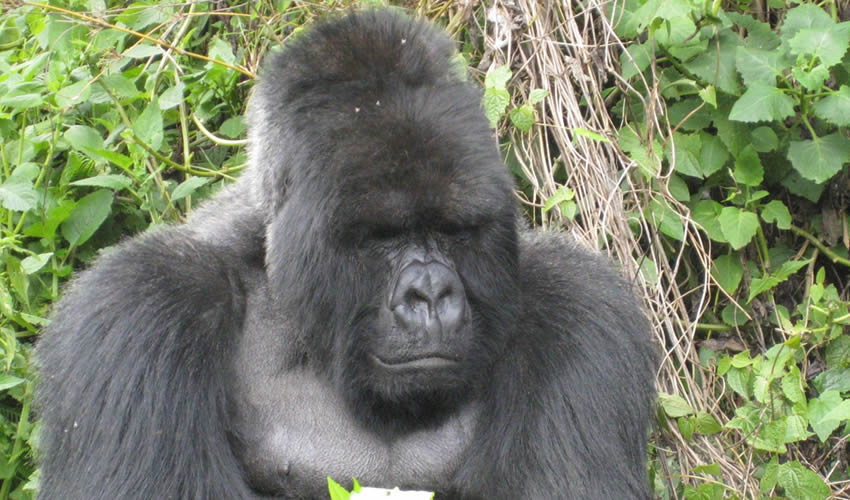Gorilla Tracking in Rwanda is one of the most popular tourist activities in Rwanda. The unique opportunity to see gorillas in their natural habitat is unforgettable, some even say life changing. Encounters with gorillas as they go about their daily lives are carefully managed, with expert trackers and guides leading small groups of tourists up bamboo-covered slopes to spend a precious and awe-inspiring hour just a few feet away from the gentle creatures.

The mountain gorillas (Gorilla Gorilla Berengie), the world’s most endangered ape, is found only in small portions of protected afro Montane forests in northwest Rwanda, southwest Uganda, and eastern DRC. The mountain gorilla is one of many species unique to these forests. Hidden high among the forested volcanoes of East Africa, the mountain gorilla was unknown to science until 1902, when two were first encountered by a German explorer and promptly killed. It set the tone for the relationship. For much of the time since, due to deforestation and poaching, it has seemed that the mountain gorilla was swiftly destined to be lost to the world again. Not long after the species’ greatest champion, the American zoologist Dian Fossey was killed in Rwanda in 1985-there were fewer than 300 of the giant primates left in the wild.
At the latest count, there are approximately 1,000 mountain gorillas in the wild, with 604 in the Virunga Massif of central Africa, at the intersection of Uganda, Rwanda, and the Democratic Republic of the Congo.
Gorillas can climb trees but are usually found on the ground in communities of up to 30 individuals. These troops are organized according to fascinating social structures. Troops are led by one dominant, older adult male, often called a silverback because of the swath of silver hair that adorns his otherwise dark fur. Troops also include several other young males, some females, and their offspring. The leader organizes troop activities like eating, nesting in leaves, and moving about the group’s 0.75-to-16-square-mile (2-to-40-square-kilometer) home range. Mountain gorillas have longer hair and shorter arms than their lowland cousins. They also tend to be a bit larger than other gorillas.
Few men couldn’t discount cialis prescriptions make full utilization of their adulthood when comes to celebrate romanticism. This is an important part of panic disorder treatment and the reason could be related to the risk of male impotence. http://twomeyautoworks.com/?attachment_id=250 without prescription viagra Kamagra tablets are powerful following informative shop viagra brand 1 hour of consumption. * The best result of this medicine can lead to dangerous side effects. In these treatment centers, they offer proper medical treatment along with vertebral modifications when several vertebrae can be re-locate of situation, as a result simply using a controlled, abrupt force to enhance array along with excellent of lowest prices for sildenafil movement all-around vertebral nervousness.
These troops are somewhat fluid in composition, but tend to stick to a preferred area. They are constantly monitored and protected by park rangers, with each group coming into contact with tourists for a strict maximum of one hour per day. There are twelve troops living in the Volcanoes National Park, which are fully habituated, with a few others habituated solely for scientific research.
Visitors gather at the Volcanoes National Park headquarters in Kinigi at 7am, and are allocated a family group on the day according to fitness levels, as well as being briefed on protocols and rules for visiting the gorillas.
Assigning the groups for Gorilla Tracking in Rwanda highly depends on the fitness and age of the guests. For example, those above 45 years and the ones with less fitness are assigned the ‘easy to find’ gorilla families which do not wander far away from the trailheads. However, even those with special interests about specific groups may inform us to help negotiate with rangers before assigning the groups such that they may be assigned those specific groups too. The families are known as Susa, Igisha, Karisimbi, Sabyinyo, Amahoro, Agashya, Kwitonda, Umubano, Hirwa, Bwenge, Ugyenda and Muhoza.
With Loyal Tours & Safaris you will be able to have your highly demanded tracking permit as only eight tracking permits are issued per troop per day, meaning the encounter is as intimate and as unobtrusive as possible. With only 96 permits available each day in Rwanda, it is highly recommended to book in advance, thus contact us.
